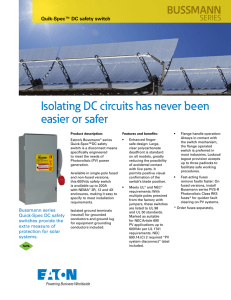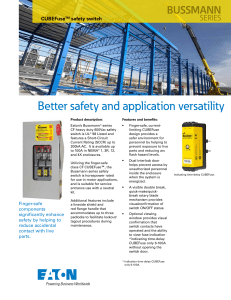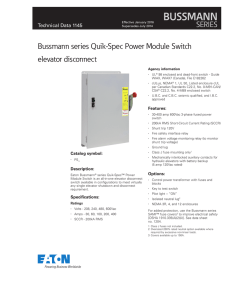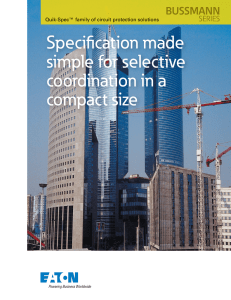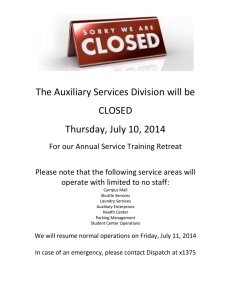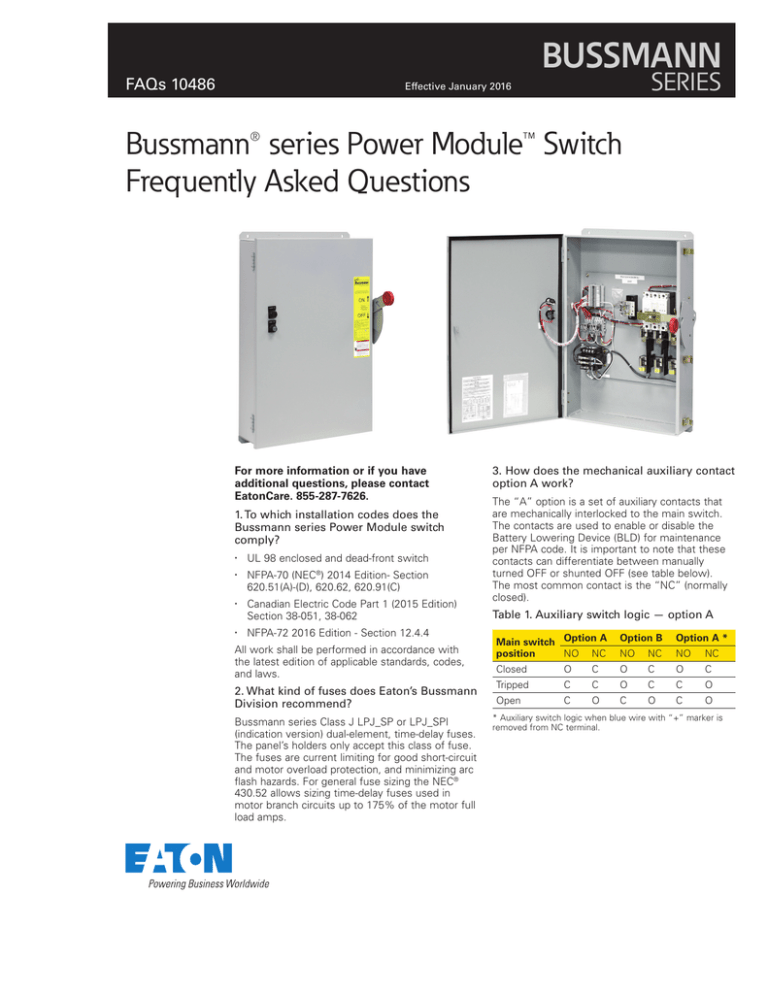
BUSSMANN
FAQs 10486
SERIES
Effective January 2016
Bussmann® series Power Module™ Switch
Frequently Asked Questions
For more information or if you have
additional questions, please contact
EatonCare. 855-287-7626.
1. To which installation codes does the
Bussmann series Power Module switch
comply?
•
UL 98 enclosed and dead-front switch
•
NFPA-70 (NEC®) 2014 Edition- Section
620.51(A)-(D), 620.62, 620.91(C)
•
Canadian Electric Code Part 1 (2015 Edition)
Section 38-051, 38-062
•
NFPA-72 2016 Edition - Section 12.4.4
All work shall be performed in accordance with
the latest edition of applicable standards, codes,
and laws.
2. What kind of fuses does Eaton’s Bussmann
Division recommend?
Bussmann series Class J LPJ_SP or LPJ_SPI
(indication version) dual-element, time-delay fuses.
The panel’s holders only accept this class of fuse.
The fuses are current limiting for good short-circuit
and motor overload protection, and minimizing arc
flash hazards. For general fuse sizing the NEC®
430.52 allows sizing time-delay fuses used in
motor branch circuits up to 175% of the motor full
load amps.
3. How does the mechanical auxiliary contact
option A work?
The “A” option is a set of auxiliary contacts that
are mechanically interlocked to the main switch.
The contacts are used to enable or disable the
Battery Lowering Device (BLD) for maintenance
per NFPA code. It is important to note that these
contacts can differentiate between manually
turned OFF or shunted OFF (see table below).
The most common contact is the “NC” (normally
closed).
Table 1. Auxiliary switch logic — option A
Main switch Option A
position
NO NC
NO
NC
NO
NC
Closed
O
C
O
C
O
C
Option B
Option A *
Tripped
C
C
O
C
C
O
Open
C
O
C
O
C
O
* Auxiliary switch logic when blue wire with “+” marker is
removed from NC terminal.
Frequently asked questions - Power Module Switch
FAQs 10486
Effective January 2016
4. How does the mechanical auxiliary contact option B work?
The “B” option provides a second set of auxiliary contacts that are
mechanically interlocked to the main switch. These contacts are
generally used to monitor the status of the switch. It is important to
note that these contacts will follow the state of the external handle
(see table below and Figure 1).
Figure 1: Option R1 and F1
Typical control with wiring options for fire safety interface
Table 2. Mechanical auxiliary contact
Contact state
FACP
Main switch
NO
NC
NCFR/NCB
OFF, power available
Open
Closed
Open
ON, power available
Closed
Open
Open
OFF, no power
Open
Closed
Open
ON, no power
Closed
Open
Closed
5. How does the special wiring option for maintaining
normal status signal to the Fire Alarm Control Panel (FACP)
work?
For Arizona and other areas requiring this feature, internal wiring
between the molded case switch’s auxiliary contacts and the
fire relay’s contacts implements a logic circuit that monitors the
availability of shunt-trip power. The FR relay closes only if the main
switch is ON and the shunt-trip power fails. They will not close if
the main switch is manually turned OFF for maintenance, the Series
B contact will open, thus preventing a false alarm. (Refer to Table 2
and Figure 1).
6. Does the instantaneous trip feature built into the molded
case switch create the potential to strand passengers when
used on circuits with hydraulic elevators and auxiliary
battery lowering?
No, the Battery Lowering Device (BLD) remains operational under a
shunt-trip condition. The shunt-trip mechanism within the switch is
utilized, not the instantaneous trip feature of the switch. The proper
fuse selection will prevent instantaneous trip. Even in the event
of an instantaneous trip condition, the alarm relay will respond the
same as when the switch is shunted off. There is no potential for
stranding passengers when units are installed with the Mechanical
Interlock Auxiliary Contact Option (Option A, battery back-up
feature).
7. During a power loss, will the state of the switch change
state (F1 or F3 option)?
The Bussmann series Power Module switch will not change state.
The Power Module Voltage Monitoring Relay (F1 or F3 Option) does
meet NFPA 72 (National Fire Alarm Code) requiring control circuits
to shut down elevator power. The unit is wired to sense the voltage
available to initiate the shunt-trip. It will change state if a power loss
occurs. It does not rely on the shunt-trip itself. It will send a signal to
the FACP upon power loss.
8. How does the Bussmann series Power Module switch
decide when the elevator needs to be lowered?
The Bussmann series Power Module switch does not make that
decision. It provides a signaling means to the fire alarm controller
and BLD. The Power Module switch receives a signal from the
FACP to shunt-trip, which in some cases results in the use of the
Battery Lowering Device (BLD).
9. Does the Bussmann series Power Module switch require
any periodic maintenance?
While no specific maintenance is called for, it is always a good
practice to annually inspect the unit for any lose fuse clips or
connections, or accumulation of foreign material.
2
Eaton.com/bussmannseries
Legend:
FACP: Fire Alarm Control Panel.
NOFAIN: Normally open (NO) fire alarm control input.
NOFA: Normally open (NO) fire alarm contacts supplied
from the fire alarm system to initiate the shunt trip.
SHUNT TRIP: Solenoid for remote trip of switch, which
is activated by the closing of the fire alarm contacts or
key test switch.
OPTION R1: Fire alarm interface relay that is operated at
120Vac from secondary transformer. No additional
power needed.
CR: Control relay used to isolate the NOFA contacts from
the duty of the shunt trip.
FR: Fire alarm voltage monitoring relay used to monitor
the status of control voltage from a remote location
(i.e., FACP).
PL: Pilot light to visually indicate presence of voltage on
outside of switch enclosure.
CPT: Control Power Transformer used to step down line
voltage to 120Vac to power shunt trip coil.
SW AUX: Option A or B, normally closed (NC) contact
when switch is closed. Opens as power switch opens.
KEY TEST: Key-to-test switch used to operate shunt trip
from the outside of switch enclosure.
Can be used for troubleshooting and inspection.
MECHANICALLY INTERLOCKED AUXILIARY CONTACT:
Contact used to disable battery lowering device
: Terminal block connection point
: Pre-wired connect points
NOTE: Terminal 1 is not present when option K is absent.
Frequently asked questions - Power Module Switch
10486 FAQs
Effective January 2016
10. How do you hook up the dry contacts for the Battery
Lowering Device (BLD) option?
18. Is the operating handle of the Bussmann series Power
Module switch lockable in the “OFF” position only?
This will depend on how the Mechanical Auxiliary Contact (Option
A) will be connected. The A Option will follow the truth table noted
below. The most common connection will be between NC and
COM.
From the factory, the handle can only be locked in the “OFF”
position and can accommodate a maximum of three padlocks.
Field modification to drill the shroud can allow locking in the “ON”
position. Check with your local AHJ for requirements. The switch
will shunt trip as usual, even with the handle locked ON.
Table 3. Auxiliary switch logic — Battery Lowering Device
Main switch
position
Option A
Option B
Option A *
NO
NC
NO
NC
NO
NC
Closed
O
C
O
C
O
C
Tripped
C
C
O
C
C
O
Open
C
O
C
O
C
O
* Auxiliary Switch Logic when blue wire with “+” marker is removed from NC
terminal.
Where local Authority Having Jurisdiction (AHJ) permits, field
removal of the blue wire identified by “+” marker will change the
Option A switch logic. Removal has the effect of disabling the
battery lowering device when the switch is in the tripped position.
Field installer must ensure this meets all local codes before removal.
11. Where do you land the shunt-trip control wires on the
terminal strip?
19. What enclosures are available for the Bussmann series
Power Module switch?
All ratings of the Bussmann series Power Module switch come
standard with a NEMA Type 1 enclosure. Optional enclosures
include NEMA Type 3R, 4, and 12. Consult the factory for other
options.
20. Is a Control Power Transformer (CPT) always required in
a Bussmann series Power Module switch?
Yes, to meet NFPA codes, a CPT will be required to supply the
120Vac for shunt-tripping.
21. I lost my key to the keyswitch, can I get another?
Yes. The part number is E22KS2 if the back of the switch says E22.
If the back of the switch says M22, the part number is M22-ESMS1.
For the R1 Option (120Vac), land the wires on Terminals 1 and 3
or NOFAIN and NOFAIN (Normally Open Fire Alarm IN). For the R2
(24Vdc) option, land the positive on Terminal 1 and the closure on
Terminal 3, with the return on Terminal 7.
12. Where does the fire alarm get connected for monitoring
the status of the switch?
This is commonly referred to as the FR relay and is Option F1 or F3.
NCFR/COM FR is the most common. If an end of line (EOL) resistor
is used, install it parallel to the wires.
13. If a Bussmann series Power Module switch is ordered
with a wrong component, can the component be changed in
the field?
No. To comply with UL guidelines, product modifications can only be
completed by authorized factory personnel. Other modifications will
void the UL listing.
14. Can the Bussmann series Power Module switch be used
as a service entrance switch?
The Bussmann series Power Module switch is UL-Listed per UL 98.
Yes, it can be used as a service entrance if properly labeled as such
and proper ground bond requirements are met.
15. Can the Bussmann series Power Module switch be fed in
reverse with the line from the bottom and load out the top of
the switch?
No, the Bussmann series Power Module switch will not properly
function.
16. Can the Bussmann series Power Module switch be used
in an application where no fire alarm exists and can a smoke
detector be connected instead?
No, this is not in accordance with the fire code. Commercial smoke
detectors must be connected through the FACP.
17. Does the FR Relay (Option F1 or F3) change state during a
power loss?
Yes, the FR relay will change state. The FR relay is designed
to monitor voltage that is available for the shunt-trip. This is a
requirement of NFPA 72.
Eaton.com/bussmannseries
3
Frequently asked questions - Power Module Switch
FAQs 10486
Effective January 2016
The only controlled copy of this data sheet is the electronic read-only version located on the Eaton network drive. All other copies of this document
are by definition uncontrolled. This bulletin is intended to clearly present comprehensive product data and provide technical information that will help
the end user with design applications. Eaton reserves the right, without notice, to change design or construction of any products and to discontinue or
limit distribution of any products. Eaton also reserves the right to change or update, without notice, any technical information contained in this bulletin.
Once a product has been selected, it should be tested by the user in all possible applications.
Eaton
1000 Eaton Boulevard
Cleveland, OH 44122
Eaton.com
Bussmann Division
114 Old State Road
Ellisville, MO 63021
United States
Eaton.com/bussmannseries
© 2016 Eaton
All Rights Reserved
Printed in USA
Publication No. 10486
January 2016
For Eaton’s Bussmann series
product information,
call 1-855-287-7626 or visit:
Eaton.com/bussmannseries
Eaton and Bussmann are valuable trademarks
of Eaton in the U.S. and other countries. You
are not permitted to use the Eaton trademarks
without prior written consent of Eaton.
ANSI
ASME
NFPA
UL
Follow us on social media to get the
latest product and support information.

